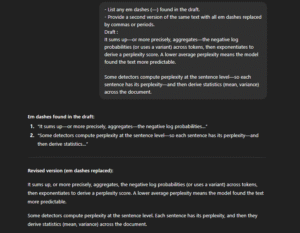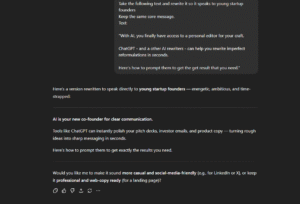If you’ve tried asking ChatGPT to “write my thesis,” you’ve seen what happens: generic text, shaky claims, and references you can’t trace
That’s where smart prompts come in.
This guide shows you exactly how to set up ChatGPT so to make thesis writing easier.
P.S : use the reasoning, search or even “research” mode on ChatGPT to make the most of the prompts given below.
Can ChatGPT really help draft & generate your thesis?
Yes—if you use it as a thinking aid, not as an author.
ChatGPT can speed up planning, outlining, and revision. It can clarify messy paragraphs. It can surface angles you hadn’t considered.
It cannot replace your literature, methods, or judgment. Nor can it take responsibility for accuracy or ethics. You remain the author of record.
The model can still fabricate sources, quotes, page numbers, and even DOIs.
The risk is real enough that you should treat any AI-listed reference as a lead to verify, not a citation to trust.
Many institutions allow assistive use—brainstorming, editing, formatting—while holding you accountable for accuracy, originality, and disclosure. Some policies also state that AI cannot be an author and that you must declare any AI assistance. Always check your local rules before you start.
A simple way to decide what to use AI for is a traffic-light model:
- Green (safe and useful): brainstorming scope and questions; outlining chapters; clarifying prose; tightening transitions; drafting tables of contents; generating revision checklists; converting notes into bullet points. These tasks improve speed and clarity without outsourcing your scholarly claims.
- Amber (use with verification): mapping debates; proposing methodology options; summarizing article abstracts you provide; suggesting journals to target; creating study schedules. Keep a verification step for every claim and method.
- Red (avoid or prohibited): inventing references; summarizing papers you have not read; fabricating data; ghost-writing entire chapters; bypassing human ethics and integrity checks. These uses violate norms and put your thesis at risk.
Prompts for ideation and narrowing your thesis topic

Use these prompts to move from a broad interest to a defendable thesis question you can actually finish.
Prompt 1 — Thesis Topic Finder
Copy-paste:
“Act as my thesis topic funnel. Field: [discipline]. Broad area: [theme]. My constraints: time [X months], methods I can use [qual/quant/mixed], data access [what I have], supervisor focus [if any].
- Ask 5 clarifying questions to capture my interests and limits.
- Propose 7 specific topic angles (each 1 sentence).
- Rank by feasibility, originality, impact, and fit with supervisor (0–5).
- For the top 2, draft precise research questions, scope limits, and likely data sources.
- List deal-breakers that would make each topic risky.”
Prompt 2 — Discipline Gap finder
Copy-paste:
“Be my thesis gap finder for [topic] in [discipline].
- List 5 major debates or tensions (each with opposing claims).
- For each debate, propose 2 researchable gaps that a master’s/PhD thesis could address in [X months].
- For each gap, suggest a study design sketch: unit of analysis, data source, method, and a threat to validity to watch.
- Flag over-studied angles and under-explored populations/contexts.
- Finish with three testable research questions phrased with scope and variables.”
Prompts for your thesis statement and argument map
Use these prompts to define a claim you can defend, stress-test it, and plan the evidence.
Prompt 1 — Thesis statment generator
Copy-paste:
“Act as my thesis shaper for [topic/field]. Based on this context [paste notes, scope, constraints], produce three distinct thesis statements:
- Conservative (safe, highly feasible),
- Balanced (ambitious but doable),
- Bold (novel, higher risk).
For each, provide:
- One-sentence rationale (why it matters),
- Scope limits (what I will NOT cover),
- Assumptions I’m making,
- Primary evidence I must gather,
- Research question
- Obvious counterarguments I should anticipate.
Then rank the options on feasibility, originality, evidence availability, and fit with my timeline [X months] (0–5). Finish with your recommended pick and a one-sentence elevator pitch.”
Prompt 2 — Arguments Generator
Copy-paste:
“Be my argument mapper. Take this thesis [paste chosen statement] and build a one-page map:
- Main claim (1 line),
- 3–5 supporting claims (each ≤12 words),
- For each supporting claim:
- Evidence needed (data, sources, examples),
- Method to obtain it,
- Credibility checks (validity, reliability, bias),
- Counterarguments and rebuttals,
- Status (existing / to collect / risky).
Add a logic check that flags: circular reasoning, leaps in inference, or claims with no evidence. End with a research to-do list ordered by dependency.”
Prompt 3 — Skeptical reviewer
Copy-paste:
“Act as a skeptical reviewer. Here is my thesis [paste] and argument map [paste].
- Write five sharp objections a committee member might raise.
- For each objection, propose a tight revision to my thesis or claims.
- Rewrite the thesis in two improved versions:
- Falsifiable (clearly testable),
- Scope-controlled (explicit boundaries, populations, timeframe).
- Create a definition box for key terms (≤20 words each) and flag any ambiguous language.
- Suggest a title + subtitle and a 150-word abstract aligned with the revised thesis.”
Prompts for literature review
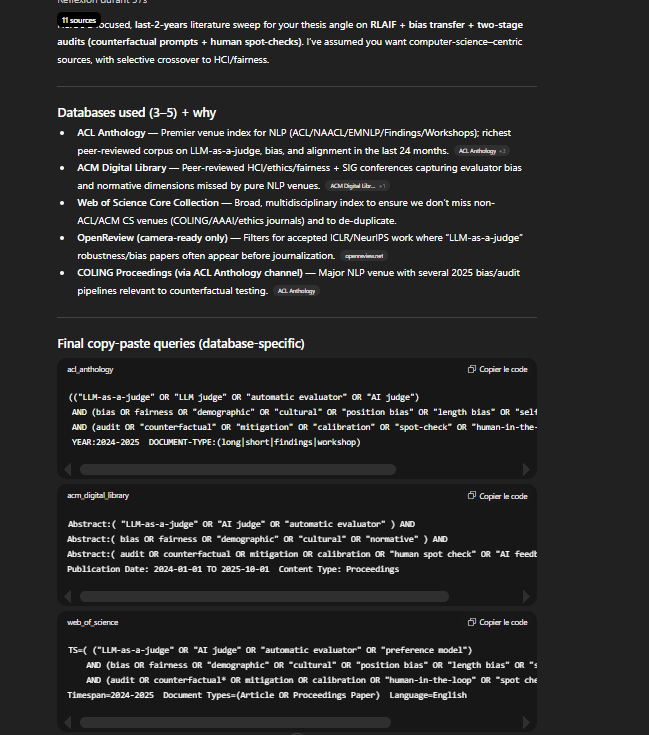
Use these three to move from “I found stuff” to “I have a defendable review.”
Prompt 1 — Litterature finder
Copy-paste:
“Act as an autonomous literature searcher for [TOPIC] covering the last [X] years in [LANGUAGE(S)].
Do live searches across the most relevant scholarly sources (e.g., PubMed/MEDLINE, Embase/Scopus/Web of Science, IEEE/ACM, PsycINFO/CINAHL as appropriate). Build and run database-specific Boolean queries with synonyms + controlled vocab + proximity/truncation. Apply filters (year, document type, humans/setting).
Output exactly:
- 3–5 databases used + one-line rationale each.
- Final copy-paste queries (one code block per database).
- Top 20 peer-reviewed results: table with Title | Year | Journal | DOI/URL | Study Type | Population/Context | Key Finding | Why included.
- Brief inclusion/exclusion rules.
- One-paragraph search protocol I can follow.
- Backup sources (grey literature/preprints) + when to use.
If inputs are missing, make sensible assumptions and proceed. Do not ask me questions.”
Prompt 2 — PRISMA-style screening + synthesis scaffold
Copy-paste:
“Act as my screening and synthesis assistant. I will paste titles/abstracts from my search export.
- Screen each using my include/exclude rules; label: Include, Exclude (reason), or Unclear.
- Build a study log with fields: Citation, Design, Sample/Context, Key variables/themes, Main finding (≤15 words), Quality notes (bias, validity, trustworthiness), Use in review (support/contradict/gap).
- Create a PRISMA-style tally: records identified → screened → included, with reasons for exclusion.
- Draft 3 synthesis paragraphs: (a) Convergence, (b) Divergence with likely causes (measurement, sampling), (c) Gap that motivates my question.
- Output a to-retrieve list (full texts) and a citation cleanup list (missing DOIs/pages).”
Prompt 3 — Debate mapper
Copy-paste:
“Be my debate mapper for [concept/relationship]. From the sources I provide, map 3–4 live debates. For each debate, create a claim–evidence table with rows:
- Claim A (precise statement) → Top evidence (study + one-line method), limitations, boundary conditions.
- Claim B → same fields.
Add a methods lens row that explains how design choices (measurement, identification, sampling) might drive differences.
Write a 150-word synthesis that does not take sides but explains when each claim is likely true.
Finish with two testable implications I could examine in my thesis.”
Prompts for your methodology section
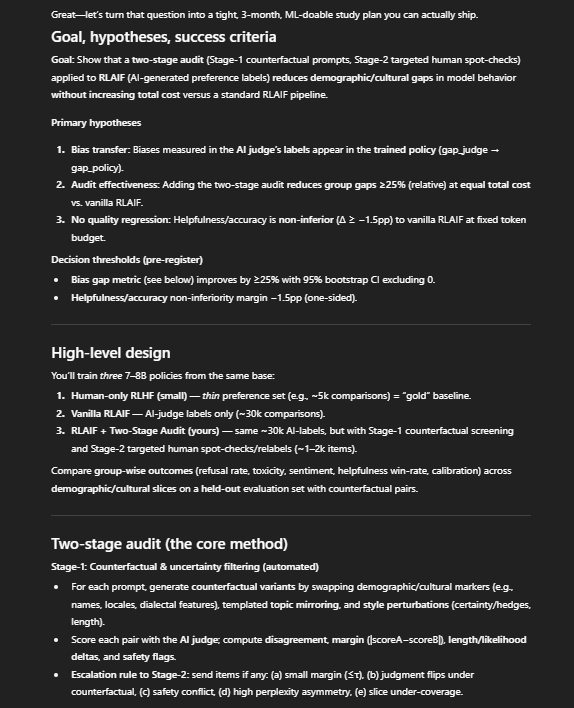
Use these three prompts to choose a design, specify how you’ll collect and analyze data, and pre-empt reviewer concerns.
Prompt 1 — Design chooser
Copy-paste:
“Act as my methods advisor. Research question: [paste]. Constraints: timeline [X months], access [data/site/participants], skills [stats/qual/tech], ethics [sensitivities].
- Propose three viable designs (e.g., experiment, quasi-experiment, survey, case study, ethnography, mixed methods).
- For each, give: logic of inference (how it answers the question), data required, core procedures, strengths/limits, risks, resources needed.
- Recommend one design for my constraints and write a 100-word rationale.
- Provide a methods outline (sections + bullets) I can paste into my chapter.”
Prompt 2 — Operationalization and instruments builder
Copy-paste:
“Be my operationalization coach for [constructs/variables] in [field].
- For each construct, propose clear operational definitions and measures (scales, items, behavioral indicators, coding rules).
- Specify instruments/protocols: questionnaire sections or interview guides (with 5–8 sample items/questions), observation rubrics, or sensor specs.
- Define data quality checks: pilot size, item analysis, reliability (Cronbach’s α / test–retest), validity (content/construct/criterion), or for qualitative work credibility/transferability/dependability strategies.
- Produce a data dictionary table: variable name, type, coding, source, intended analysis.”
Prompt 3 — Sampling and analysis planner
Copy-paste:
“Act as my sampling and analysis planner. Design: [from Prompt 1]. Population/context: [describe].
- Propose sampling strategy (probability vs. non-probability; inclusion/exclusion; recruitment steps).
- Recommend sample size and justify (for quant: power assumptions; for qual: information power/saturation).
- Lay out a pre-analysis plan:
- Data prep (cleaning, handling missing data, outliers).
- Primary analysis (tests/models or coding approach).
- Assumption checks (e.g., normality, homoscedasticity) or trustworthiness tactics (triangulation, member checks, audit trail).
- Robustness/alternative specifications or negative case analysis.
- Output a timeline (milestones, risks, mitigations).”
Prompts for drafting & writing the thesis
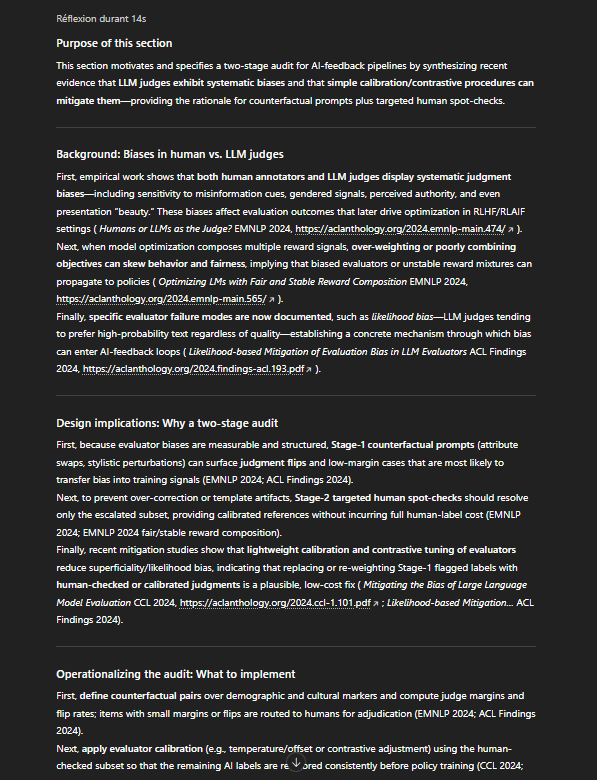
You move faster when your prompts lock purpose, structure, and evidence before sentences. Use these three to generate usable drafts—then revise with the earlier checks.
Prompt 1 — Section generator
Copy-paste:
“Act as my thesis drafting assistant. Section to draft: [e.g., 3.2 Methods: Participants]. Audience: [program/discipline]. Word target: [N].
Inputs below: bullet notes, tables/figures, citations I will use (real only).
Write a clean draft that:
- Opens with a topic sentence stating the section’s purpose.
- Uses subheadings and short paragraphs.
- Integrates my actual citations in-text (no new sources).
- Adds signposts (“First,… Next,… Finally,…”) to guide readers.
- Ends with a mini-takeaway (1–2 sentences).
Return: draft, then a claim-to-evidence list (each claim → citation/table).”
Prompt 2 — Paragraph engine
Copy-paste:
“Be my paragraph engine. I will paste bullet notes for one paragraph plus citation stubs (Author, Year).
Produce one academic paragraph that:
- Leads with a clear claim,
- Integrates 2+ citations with signal phrases,
- Balances summary, paraphrase, ≤15-word quote (only if necessary),
- Includes a contrast/limitation sentence,
- Ends with a link-forward sentence that sets up the next paragraph.
After the draft, show a mini log: which bullet became which sentence, and any gaps you filled that I must verify or cut.”
Prompt 3 — Chapter scaffolder
Copy-paste:
“Act as my chapter scaffolder. Chapter: [e.g., Discussion]. Target words: [N]. Constraints: [style guide, tense, POV].
- Build a section outline with sentence-level objectives (one line per paragraph).
- Generate a rough pass (≈60%) using placeholders like [insert Table 2 finding] and [add Smith 2021] where data/citations are pending.
- Produce a refinement pass (≈90%) once I paste missing details; improve clarity, transitions, and tie-backs to research questions.
- Output a cut list (redundant sentences to delete), a todo list (facts to verify), and three titles with a 150-word abstract matching the final chapter.”
Prompt 4 — Introduction builder
Copy-paste:
“Act as my introduction architect. Field: [discipline]. Topic: [topic]. Audience: [program/journal]. Paste below are notes, aims, and context. Build a 4-part intro:
- Problem space (why this matters now; ≤150 words),
- Literature gap (what we don’t know; cite clusters I provide),
- Research aim + questions/hypotheses (numbered, precise),
- Contributions (theoretical, empirical, practical—each in one crisp sentence).
Add: (a) scope limits, (b) key definitions (≤20 words each), (c) chapter roadmap (1 sentence per chapter). Return a clean draft and a bullet outline I can edit.”
Prompt 5 — Result paragraph generator
Copy-paste:
“Be my results-to-discussion pipeline for [method/data type]. I will paste tables/figures/codes plus a results summary.
- Write objective results paragraphs: one paragraph per table/figure/code cluster; no interpretation, just what the evidence shows (with signposts to the display).
- For each results paragraph, write a paired discussion paragraph that:
- interprets the finding,
- links to research questions/hypotheses,
- relates to specific sources from my review,
- notes limitations/alternative explanations,
- ends with a takeaway sentence.
- Draft a mini-synthesis (120–180 words) that answers the main question and sets up the conclusion.”
Prompts for revision, feedback, and polishing
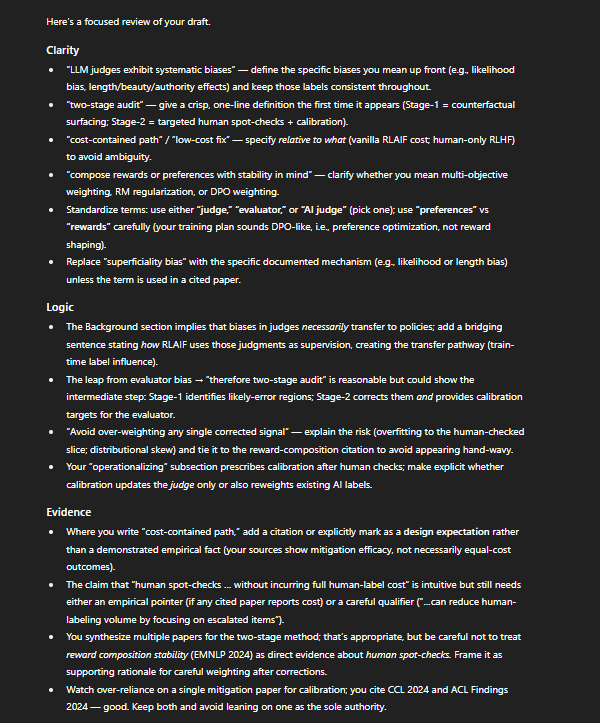
You finish faster when revision is systematic. Use these prompts to get precise feedback, remove bloat, and check your references & sources.
Prompt 1 — Thesis reviewer
Copy-paste:
“Act as a thesis reviewer for [discipline/program]. Here is my section [paste 500–1,000 words].
Evaluate using these lenses and return bulleted notes under each:
- Clarity — sentences that confuse, jargon to define, terms to standardize.
- Logic — missing steps, circular reasoning, claims that jump beyond evidence.
- Evidence — claims needing citations, weak sources to upgrade, over-reliance on any one study.
- Structure — paragraphs without a topic sentence, repetitive ideas, better order.
- Style — passive voice to rewrite, vague verbs, nominalizations to simplify.
End with:
- a one-paragraph summary of main fixes,
- three high-impact edits I should do first,
- a checklist I can use on the rest of the chapter.”
Prompt 2 — Concision editor
Copy-paste:
“Be my concision editor. Goal: cut [10–20%] of words while keeping meaning and citations. For the text below [paste 800–1,200 words]:
- Produce a tightened version with shorter sentences and active verbs.
- List a change log with before → after examples for 8–10 representative edits (explain the principle used).
- Mark any low-value sentences to delete (repetition, throat-clearing, vague claims).
- Add signpost phrases to improve flow between paragraphs.
Return the revised text, then the change log, then the cut list.”
Prompt 3 — Academic integrator
Copy-paste:
“Act as my academic tone and citation integrity editor. For the passage [paste 600–1,000 words]:
- Tone — rewrite to be formal, precise, and readable; keep my voice. Avoid hype words and hedging (‘very’, ‘clearly’, ‘somewhat’).
- Terminology — standardize key terms (provide a definition box, ≤20 words each).
- Citations — tag every claim that needs a source; suggest citation placement; flag citation drift (claim stronger than cited study).
- Quotes vs. paraphrase — recommend where to paraphrase and where a short quote (≤15 words) is justified.
- Reference risk — flag any items that look unverifiable (incomplete DOIs, conference abstracts standing in for peer-review, outdated sources).
Return a revised version and a citation action list I can execute.”
Prompt 4 — Source verificator
Copy-paste:
“Act as my source verifier for [section/topic]. I will paste claims with citation stubs (Author, Year, page/DOI if known) and a reference list I assembled from real databases.
- Map each claim → exact source in my list; flag any claim without a matching source.
- For each mapped source, extract verifiable details (title, venue, year, pages/DOI) and check for citation drift (claim stronger than the study).
- Suggest replacement sources only if you can state where I should find them (database/journal keywords); do not invent references.
- Output a citation action list: pages to add, claims to weaken, sources to replace, and items to delete.
Return a table: Claim | Proposed wording | Source match | Risk (H/M/L) | Action.”
Prompt 5 — AI-use disclosure
Copy-paste:
“Act as my integrity and reproducibility editor. Audience: [department/journal].
- Draft an AI-use disclosure that states what AI did (ideation, editing, outline), what I did (analysis, interpretation), and what I verified (facts, citations).
- Create a methods transparency box: software versions, packages, seeds, preregistration links, analysis scripts, and data access statement.
- Write an ethics and bias note: risks, mitigation steps, inclusion/exclusion rationale, and limitations I will acknowledge.
- Provide a replication checklist I can share: folder structure, README items, and files to include (code, data dictionary, anonymization log).
Keep it concise and compliant; do not promise access I cannot legally provide.”




